Vodafone Strategic Plan: External, Internal Analysis & Competition
VerifiedAdded on 2023/06/13
|21
|5542
|295
Report
AI Summary
This report provides a strategic management analysis of Vodafone Group Plc., a multinational telecommunications company. It evaluates the impact of the external environment using PESTEL analysis, stakeholder analysis, and Porter's Five Forces, and assesses the internal environment through SWOT analysis, Porter's Value Chain analysis, and VRIO analysis. The report further examines Vodafone's competitive position and explores strategic growth options using Porter's generic strategies, Bowman's strategy clock, and Ansoff's growth matrix. The analysis aims to inform strategic decision-making and improve Vodafone's business performance. Desklib provides access to this document and a wealth of study resources for students.
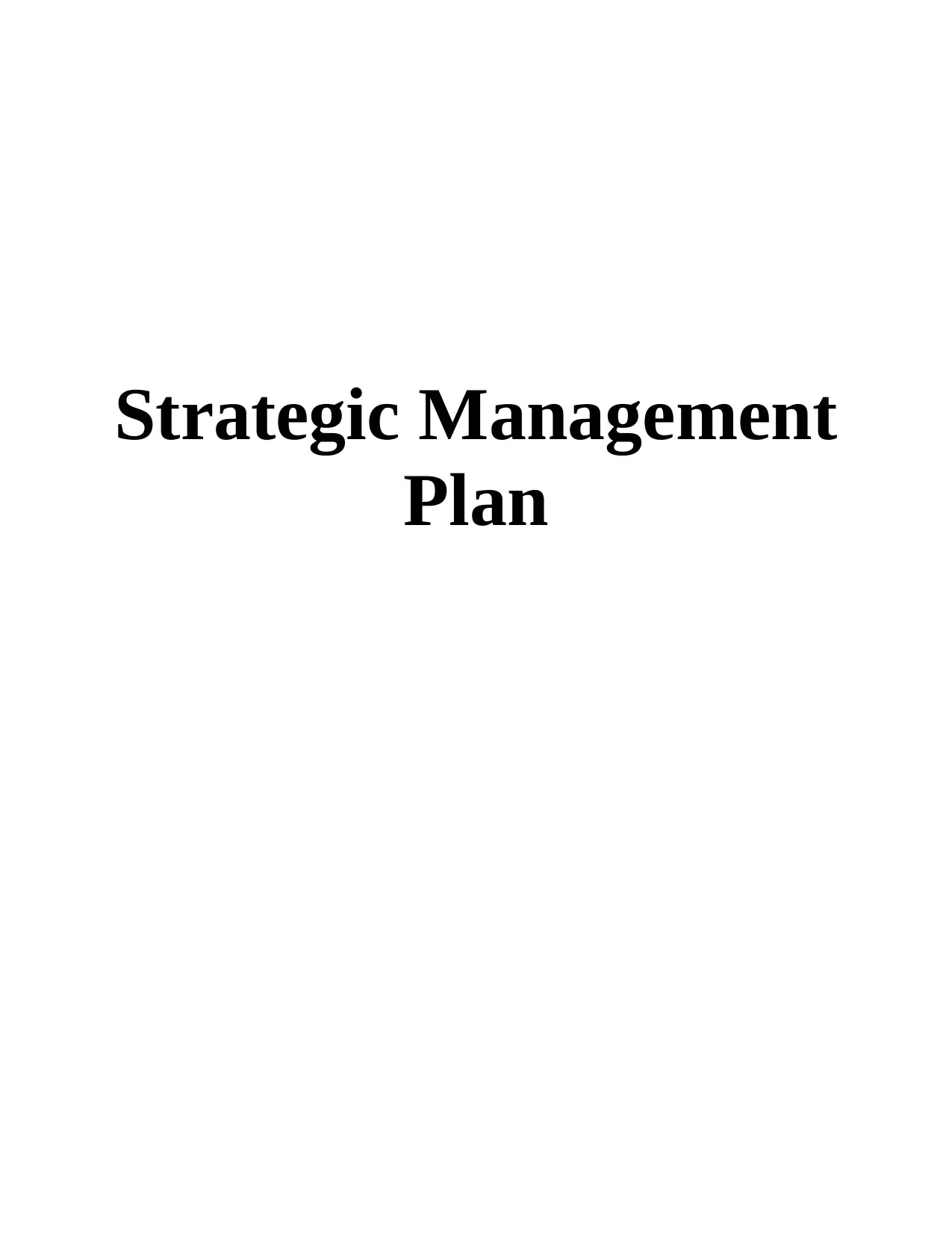
Strategic Management
Plan
Plan
Paraphrase This Document
Need a fresh take? Get an instant paraphrase of this document with our AI Paraphraser
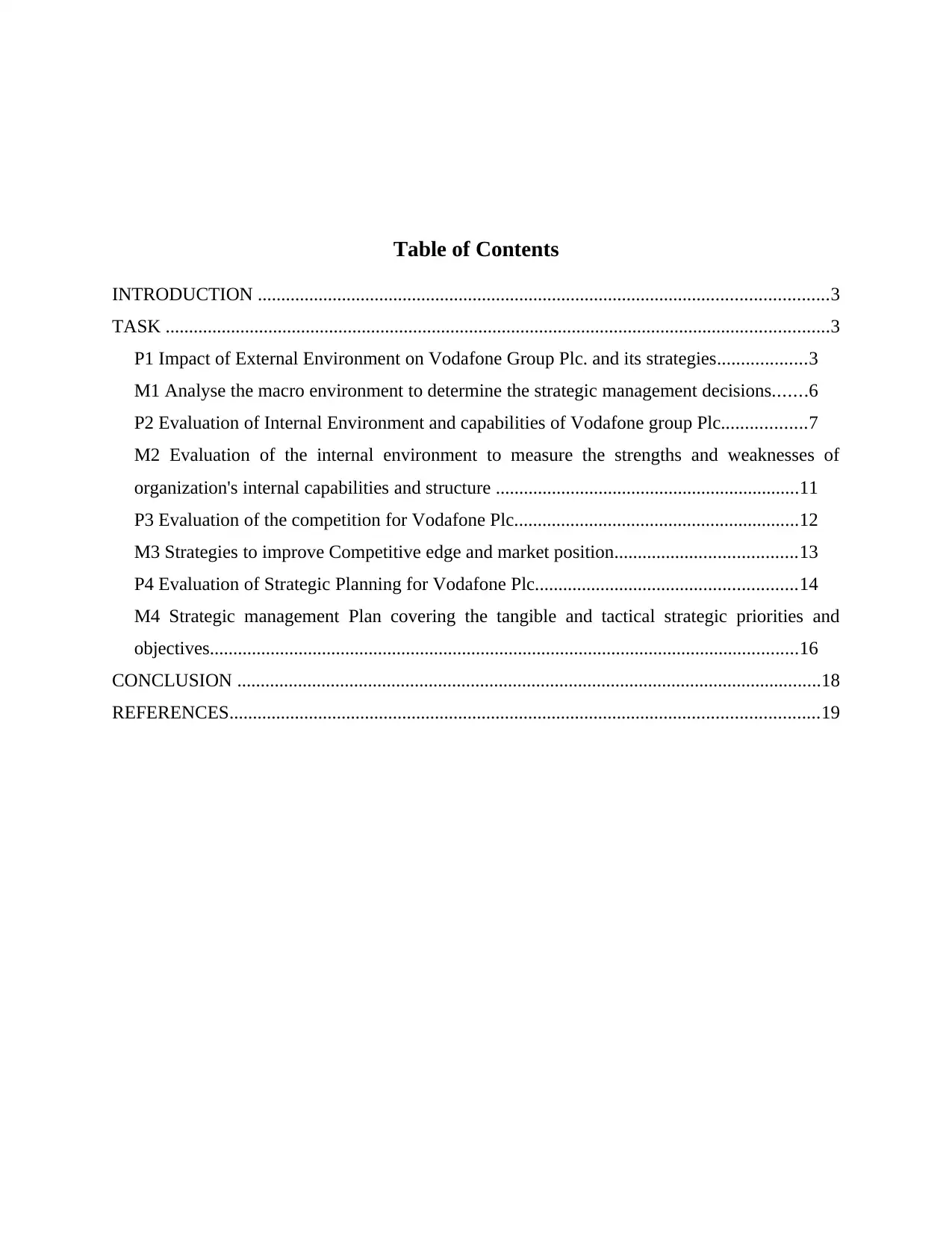
Table of Contents
INTRODUCTION ..........................................................................................................................3
TASK ..............................................................................................................................................3
P1 Impact of External Environment on Vodafone Group Plc. and its strategies...................3
M1 Analyse the macro environment to determine the strategic management decisions.......6
P2 Evaluation of Internal Environment and capabilities of Vodafone group Plc..................7
M2 Evaluation of the internal environment to measure the strengths and weaknesses of
organization's internal capabilities and structure .................................................................11
P3 Evaluation of the competition for Vodafone Plc.............................................................12
M3 Strategies to improve Competitive edge and market position.......................................13
P4 Evaluation of Strategic Planning for Vodafone Plc........................................................14
M4 Strategic management Plan covering the tangible and tactical strategic priorities and
objectives..............................................................................................................................16
CONCLUSION .............................................................................................................................18
REFERENCES..............................................................................................................................19
INTRODUCTION ..........................................................................................................................3
TASK ..............................................................................................................................................3
P1 Impact of External Environment on Vodafone Group Plc. and its strategies...................3
M1 Analyse the macro environment to determine the strategic management decisions.......6
P2 Evaluation of Internal Environment and capabilities of Vodafone group Plc..................7
M2 Evaluation of the internal environment to measure the strengths and weaknesses of
organization's internal capabilities and structure .................................................................11
P3 Evaluation of the competition for Vodafone Plc.............................................................12
M3 Strategies to improve Competitive edge and market position.......................................13
P4 Evaluation of Strategic Planning for Vodafone Plc........................................................14
M4 Strategic management Plan covering the tangible and tactical strategic priorities and
objectives..............................................................................................................................16
CONCLUSION .............................................................................................................................18
REFERENCES..............................................................................................................................19
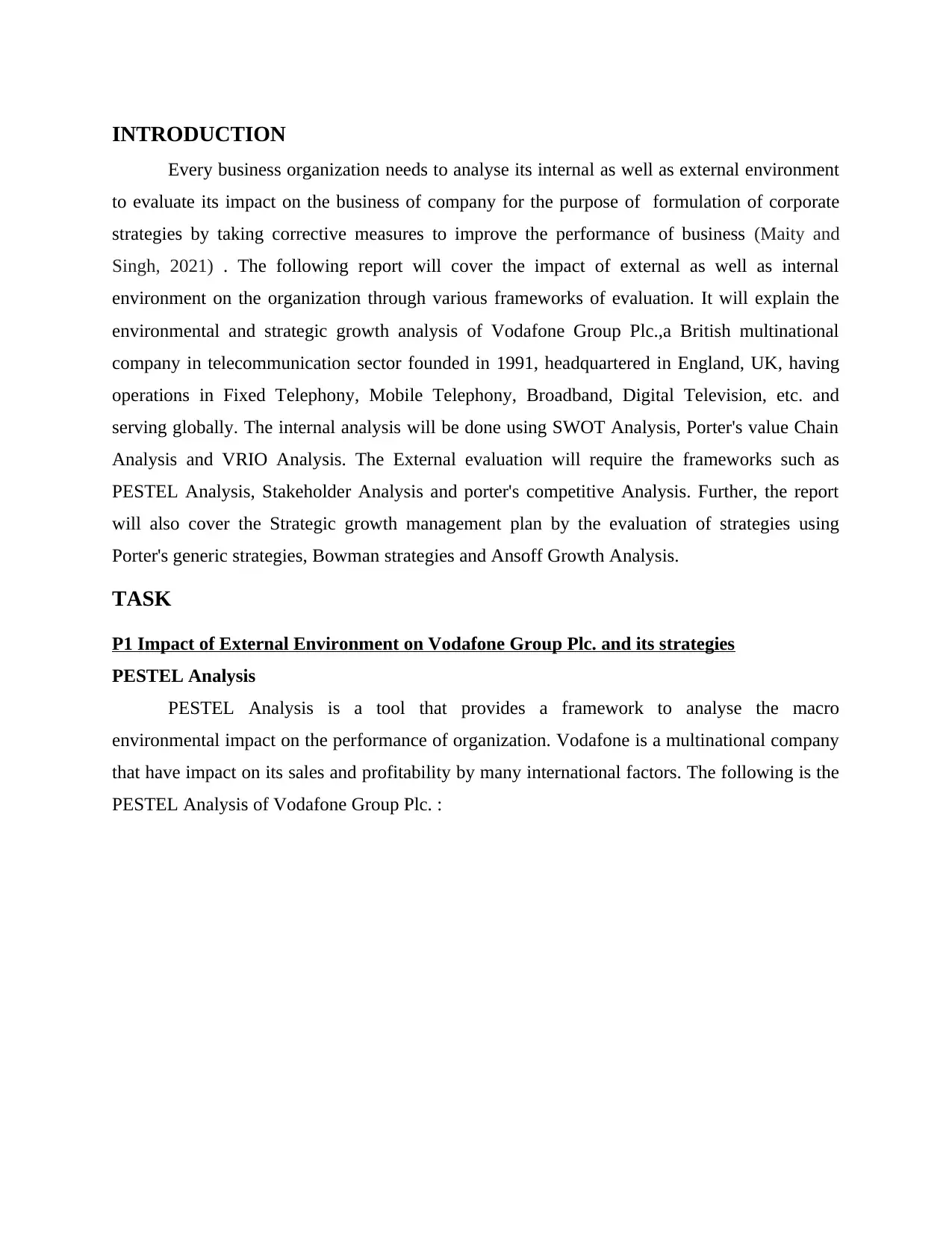
INTRODUCTION
Every business organization needs to analyse its internal as well as external environment
to evaluate its impact on the business of company for the purpose of formulation of corporate
strategies by taking corrective measures to improve the performance of business (Maity and
Singh, 2021) . The following report will cover the impact of external as well as internal
environment on the organization through various frameworks of evaluation. It will explain the
environmental and strategic growth analysis of Vodafone Group Plc.,a British multinational
company in telecommunication sector founded in 1991, headquartered in England, UK, having
operations in Fixed Telephony, Mobile Telephony, Broadband, Digital Television, etc. and
serving globally. The internal analysis will be done using SWOT Analysis, Porter's value Chain
Analysis and VRIO Analysis. The External evaluation will require the frameworks such as
PESTEL Analysis, Stakeholder Analysis and porter's competitive Analysis. Further, the report
will also cover the Strategic growth management plan by the evaluation of strategies using
Porter's generic strategies, Bowman strategies and Ansoff Growth Analysis.
TASK
P1 Impact of External Environment on Vodafone Group Plc. and its strategies
PESTEL Analysis
PESTEL Analysis is a tool that provides a framework to analyse the macro
environmental impact on the performance of organization. Vodafone is a multinational company
that have impact on its sales and profitability by many international factors. The following is the
PESTEL Analysis of Vodafone Group Plc. :
Every business organization needs to analyse its internal as well as external environment
to evaluate its impact on the business of company for the purpose of formulation of corporate
strategies by taking corrective measures to improve the performance of business (Maity and
Singh, 2021) . The following report will cover the impact of external as well as internal
environment on the organization through various frameworks of evaluation. It will explain the
environmental and strategic growth analysis of Vodafone Group Plc.,a British multinational
company in telecommunication sector founded in 1991, headquartered in England, UK, having
operations in Fixed Telephony, Mobile Telephony, Broadband, Digital Television, etc. and
serving globally. The internal analysis will be done using SWOT Analysis, Porter's value Chain
Analysis and VRIO Analysis. The External evaluation will require the frameworks such as
PESTEL Analysis, Stakeholder Analysis and porter's competitive Analysis. Further, the report
will also cover the Strategic growth management plan by the evaluation of strategies using
Porter's generic strategies, Bowman strategies and Ansoff Growth Analysis.
TASK
P1 Impact of External Environment on Vodafone Group Plc. and its strategies
PESTEL Analysis
PESTEL Analysis is a tool that provides a framework to analyse the macro
environmental impact on the performance of organization. Vodafone is a multinational company
that have impact on its sales and profitability by many international factors. The following is the
PESTEL Analysis of Vodafone Group Plc. :
⊘ This is a preview!⊘
Do you want full access?
Subscribe today to unlock all pages.

Trusted by 1+ million students worldwide
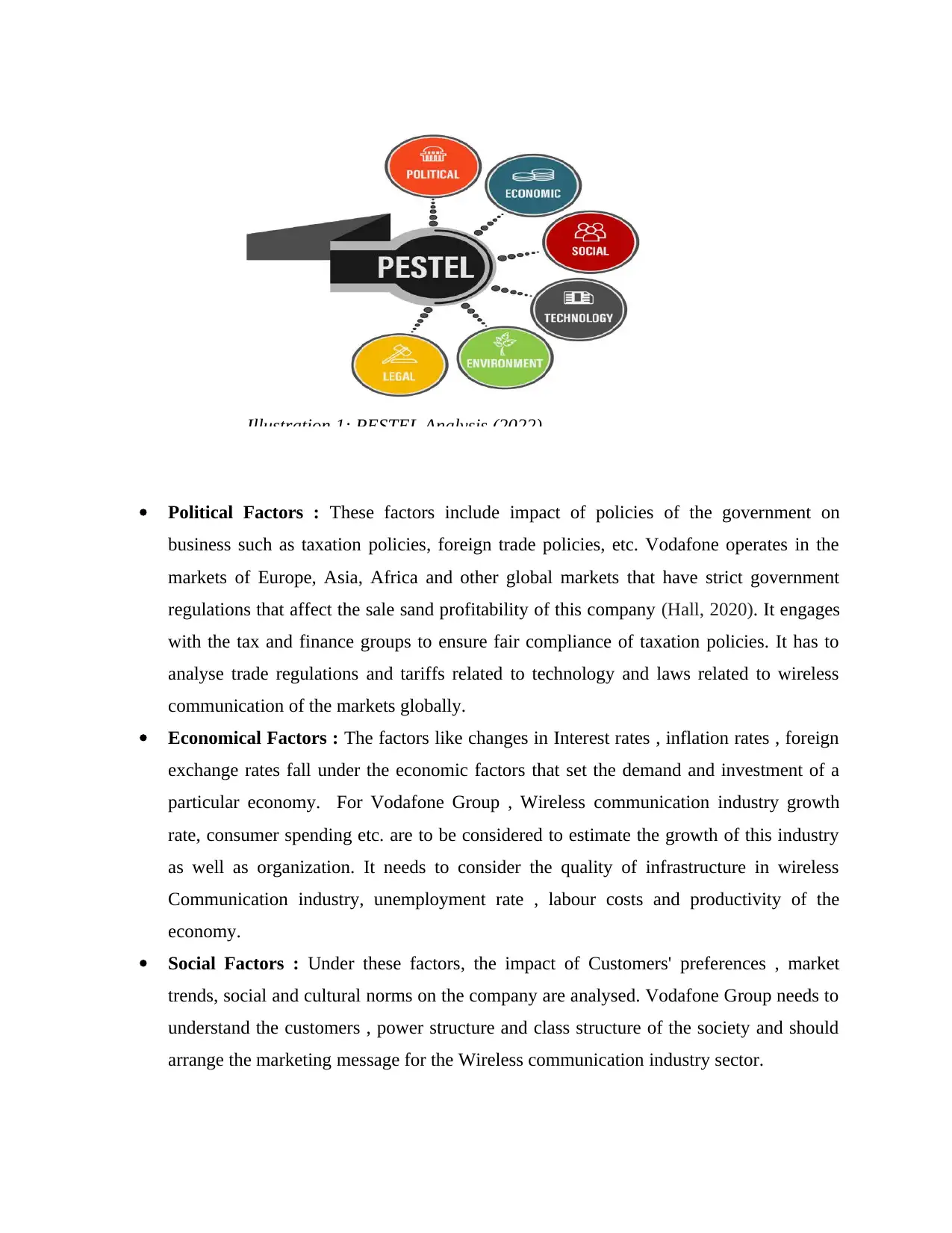
Political Factors : These factors include impact of policies of the government on
business such as taxation policies, foreign trade policies, etc. Vodafone operates in the
markets of Europe, Asia, Africa and other global markets that have strict government
regulations that affect the sale sand profitability of this company (Hall, 2020). It engages
with the tax and finance groups to ensure fair compliance of taxation policies. It has to
analyse trade regulations and tariffs related to technology and laws related to wireless
communication of the markets globally.
Economical Factors : The factors like changes in Interest rates , inflation rates , foreign
exchange rates fall under the economic factors that set the demand and investment of a
particular economy. For Vodafone Group , Wireless communication industry growth
rate, consumer spending etc. are to be considered to estimate the growth of this industry
as well as organization. It needs to consider the quality of infrastructure in wireless
Communication industry, unemployment rate , labour costs and productivity of the
economy.
Social Factors : Under these factors, the impact of Customers' preferences , market
trends, social and cultural norms on the company are analysed. Vodafone Group needs to
understand the customers , power structure and class structure of the society and should
arrange the marketing message for the Wireless communication industry sector.
Illustration 1: PESTEL Analysis (2022)
business such as taxation policies, foreign trade policies, etc. Vodafone operates in the
markets of Europe, Asia, Africa and other global markets that have strict government
regulations that affect the sale sand profitability of this company (Hall, 2020). It engages
with the tax and finance groups to ensure fair compliance of taxation policies. It has to
analyse trade regulations and tariffs related to technology and laws related to wireless
communication of the markets globally.
Economical Factors : The factors like changes in Interest rates , inflation rates , foreign
exchange rates fall under the economic factors that set the demand and investment of a
particular economy. For Vodafone Group , Wireless communication industry growth
rate, consumer spending etc. are to be considered to estimate the growth of this industry
as well as organization. It needs to consider the quality of infrastructure in wireless
Communication industry, unemployment rate , labour costs and productivity of the
economy.
Social Factors : Under these factors, the impact of Customers' preferences , market
trends, social and cultural norms on the company are analysed. Vodafone Group needs to
understand the customers , power structure and class structure of the society and should
arrange the marketing message for the Wireless communication industry sector.
Illustration 1: PESTEL Analysis (2022)
Paraphrase This Document
Need a fresh take? Get an instant paraphrase of this document with our AI Paraphraser
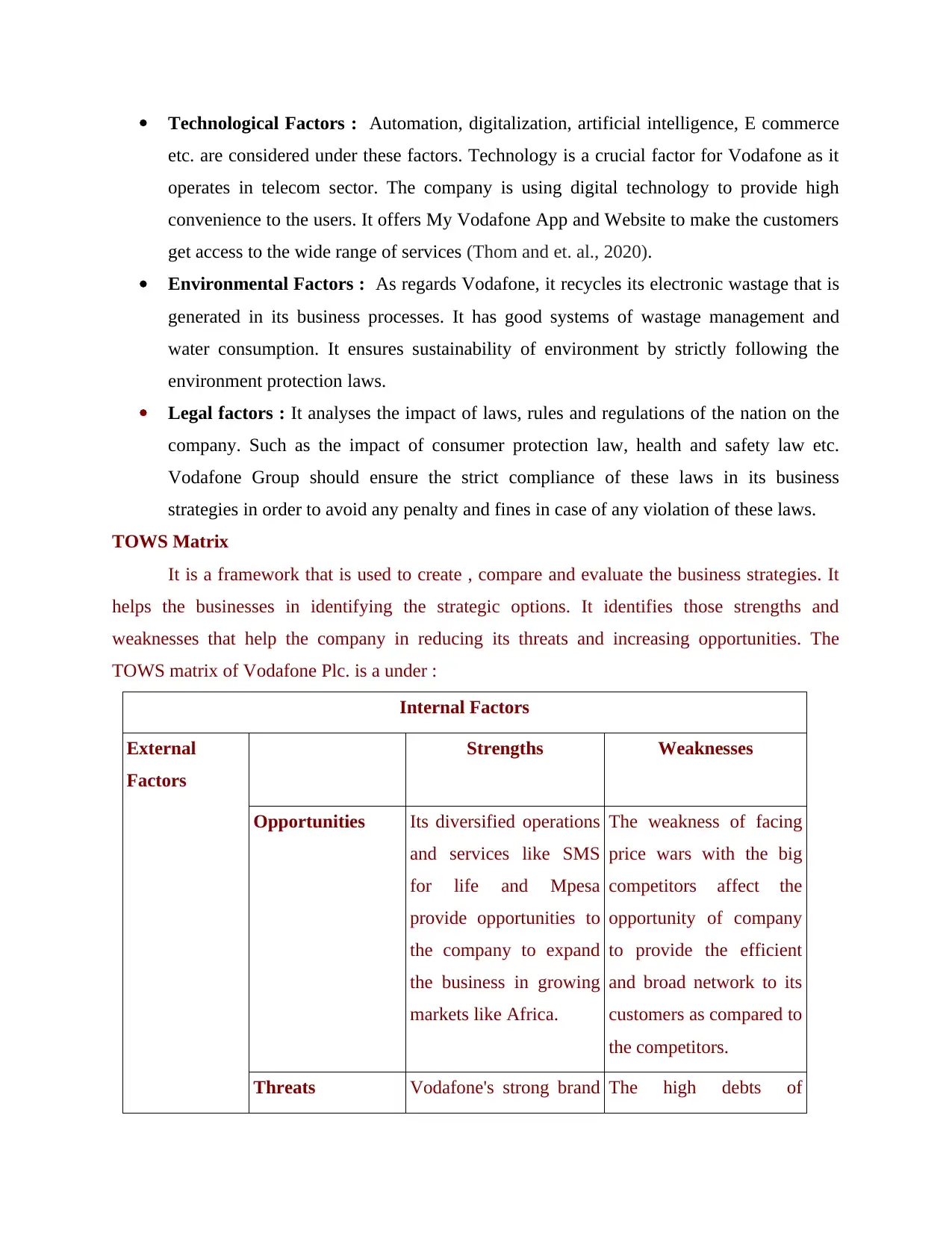
Technological Factors : Automation, digitalization, artificial intelligence, E commerce
etc. are considered under these factors. Technology is a crucial factor for Vodafone as it
operates in telecom sector. The company is using digital technology to provide high
convenience to the users. It offers My Vodafone App and Website to make the customers
get access to the wide range of services (Thom and et. al., 2020).
Environmental Factors : As regards Vodafone, it recycles its electronic wastage that is
generated in its business processes. It has good systems of wastage management and
water consumption. It ensures sustainability of environment by strictly following the
environment protection laws.
Legal factors : It analyses the impact of laws, rules and regulations of the nation on the
company. Such as the impact of consumer protection law, health and safety law etc.
Vodafone Group should ensure the strict compliance of these laws in its business
strategies in order to avoid any penalty and fines in case of any violation of these laws.
TOWS Matrix
It is a framework that is used to create , compare and evaluate the business strategies. It
helps the businesses in identifying the strategic options. It identifies those strengths and
weaknesses that help the company in reducing its threats and increasing opportunities. The
TOWS matrix of Vodafone Plc. is a under :
Internal Factors
External
Factors
Strengths Weaknesses
Opportunities Its diversified operations
and services like SMS
for life and Mpesa
provide opportunities to
the company to expand
the business in growing
markets like Africa.
The weakness of facing
price wars with the big
competitors affect the
opportunity of company
to provide the efficient
and broad network to its
customers as compared to
the competitors.
Threats Vodafone's strong brand The high debts of
etc. are considered under these factors. Technology is a crucial factor for Vodafone as it
operates in telecom sector. The company is using digital technology to provide high
convenience to the users. It offers My Vodafone App and Website to make the customers
get access to the wide range of services (Thom and et. al., 2020).
Environmental Factors : As regards Vodafone, it recycles its electronic wastage that is
generated in its business processes. It has good systems of wastage management and
water consumption. It ensures sustainability of environment by strictly following the
environment protection laws.
Legal factors : It analyses the impact of laws, rules and regulations of the nation on the
company. Such as the impact of consumer protection law, health and safety law etc.
Vodafone Group should ensure the strict compliance of these laws in its business
strategies in order to avoid any penalty and fines in case of any violation of these laws.
TOWS Matrix
It is a framework that is used to create , compare and evaluate the business strategies. It
helps the businesses in identifying the strategic options. It identifies those strengths and
weaknesses that help the company in reducing its threats and increasing opportunities. The
TOWS matrix of Vodafone Plc. is a under :
Internal Factors
External
Factors
Strengths Weaknesses
Opportunities Its diversified operations
and services like SMS
for life and Mpesa
provide opportunities to
the company to expand
the business in growing
markets like Africa.
The weakness of facing
price wars with the big
competitors affect the
opportunity of company
to provide the efficient
and broad network to its
customers as compared to
the competitors.
Threats Vodafone's strong brand The high debts of
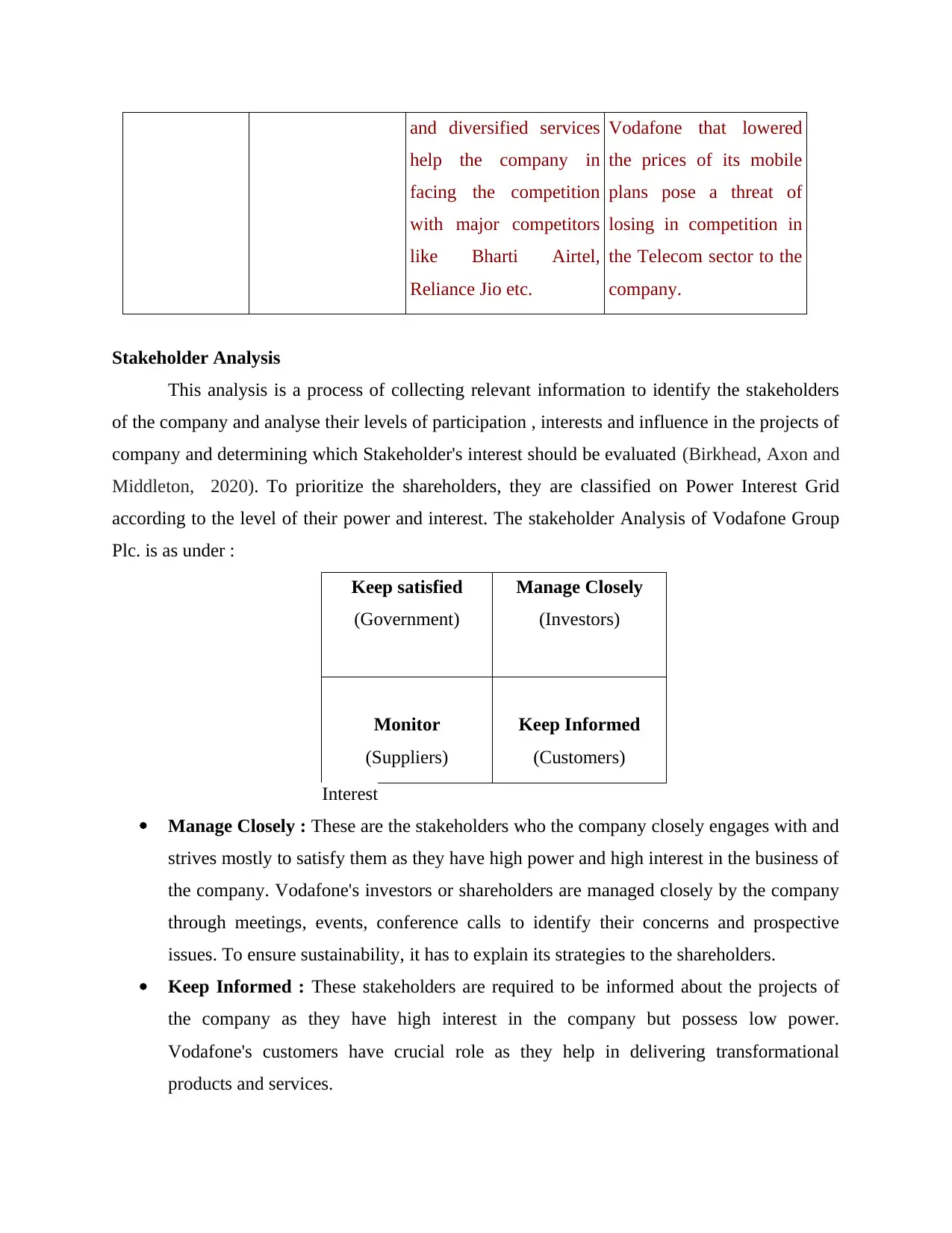
and diversified services
help the company in
facing the competition
with major competitors
like Bharti Airtel,
Reliance Jio etc.
Vodafone that lowered
the prices of its mobile
plans pose a threat of
losing in competition in
the Telecom sector to the
company.
Stakeholder Analysis
This analysis is a process of collecting relevant information to identify the stakeholders
of the company and analyse their levels of participation , interests and influence in the projects of
company and determining which Stakeholder's interest should be evaluated (Birkhead, Axon and
Middleton, 2020). To prioritize the shareholders, they are classified on Power Interest Grid
according to the level of their power and interest. The stakeholder Analysis of Vodafone Group
Plc. is as under :
Keep satisfied
(Government)
Manage Closely
(Investors)
Monitor
(Suppliers)
Keep Informed
(Customers)
Interest
Manage Closely : These are the stakeholders who the company closely engages with and
strives mostly to satisfy them as they have high power and high interest in the business of
the company. Vodafone's investors or shareholders are managed closely by the company
through meetings, events, conference calls to identify their concerns and prospective
issues. To ensure sustainability, it has to explain its strategies to the shareholders.
Keep Informed : These stakeholders are required to be informed about the projects of
the company as they have high interest in the company but possess low power.
Vodafone's customers have crucial role as they help in delivering transformational
products and services.
help the company in
facing the competition
with major competitors
like Bharti Airtel,
Reliance Jio etc.
Vodafone that lowered
the prices of its mobile
plans pose a threat of
losing in competition in
the Telecom sector to the
company.
Stakeholder Analysis
This analysis is a process of collecting relevant information to identify the stakeholders
of the company and analyse their levels of participation , interests and influence in the projects of
company and determining which Stakeholder's interest should be evaluated (Birkhead, Axon and
Middleton, 2020). To prioritize the shareholders, they are classified on Power Interest Grid
according to the level of their power and interest. The stakeholder Analysis of Vodafone Group
Plc. is as under :
Keep satisfied
(Government)
Manage Closely
(Investors)
Monitor
(Suppliers)
Keep Informed
(Customers)
Interest
Manage Closely : These are the stakeholders who the company closely engages with and
strives mostly to satisfy them as they have high power and high interest in the business of
the company. Vodafone's investors or shareholders are managed closely by the company
through meetings, events, conference calls to identify their concerns and prospective
issues. To ensure sustainability, it has to explain its strategies to the shareholders.
Keep Informed : These stakeholders are required to be informed about the projects of
the company as they have high interest in the company but possess low power.
Vodafone's customers have crucial role as they help in delivering transformational
products and services.
⊘ This is a preview!⊘
Do you want full access?
Subscribe today to unlock all pages.

Trusted by 1+ million students worldwide
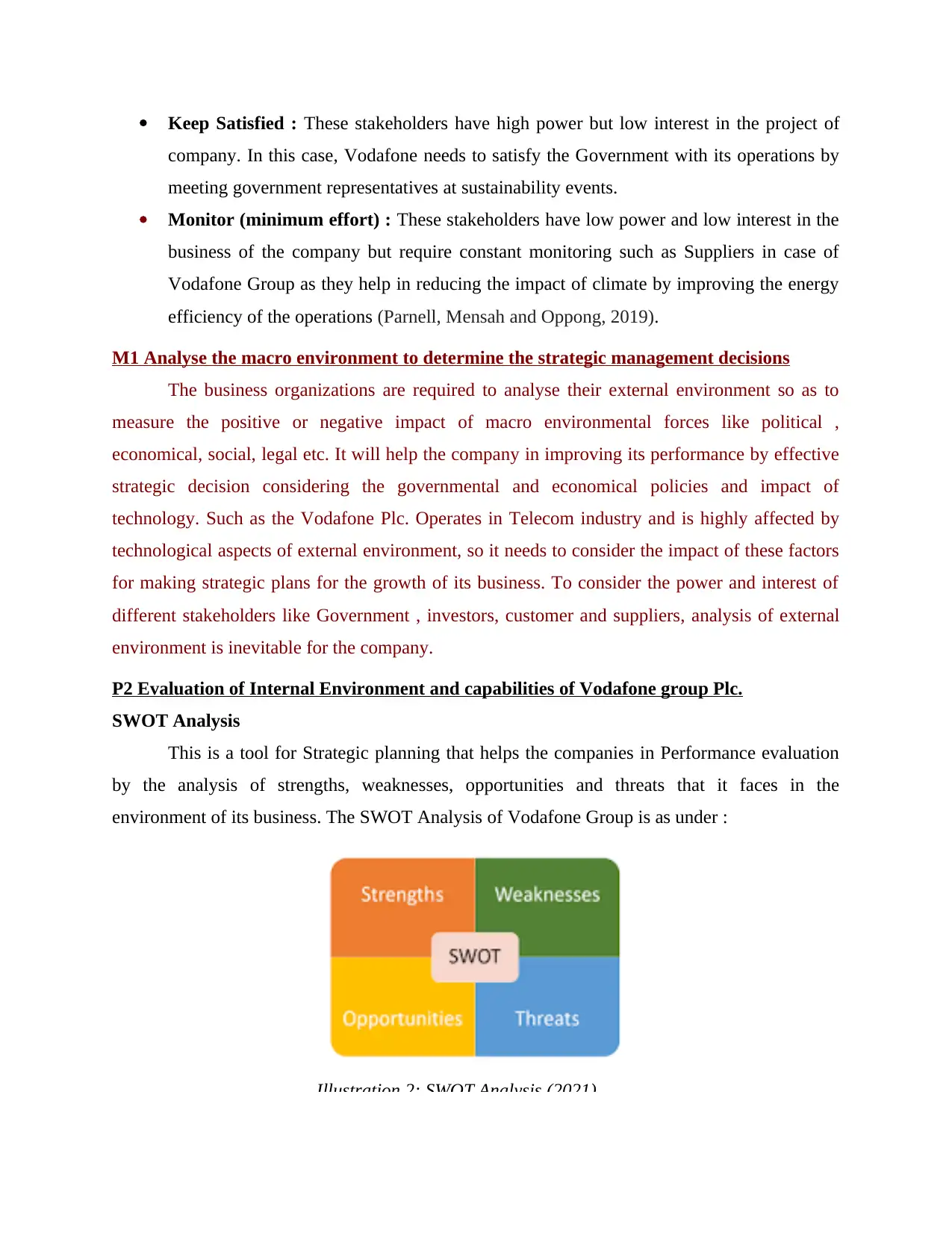
Keep Satisfied : These stakeholders have high power but low interest in the project of
company. In this case, Vodafone needs to satisfy the Government with its operations by
meeting government representatives at sustainability events.
Monitor (minimum effort) : These stakeholders have low power and low interest in the
business of the company but require constant monitoring such as Suppliers in case of
Vodafone Group as they help in reducing the impact of climate by improving the energy
efficiency of the operations (Parnell, Mensah and Oppong, 2019).
M1 Analyse the macro environment to determine the strategic management decisions
The business organizations are required to analyse their external environment so as to
measure the positive or negative impact of macro environmental forces like political ,
economical, social, legal etc. It will help the company in improving its performance by effective
strategic decision considering the governmental and economical policies and impact of
technology. Such as the Vodafone Plc. Operates in Telecom industry and is highly affected by
technological aspects of external environment, so it needs to consider the impact of these factors
for making strategic plans for the growth of its business. To consider the power and interest of
different stakeholders like Government , investors, customer and suppliers, analysis of external
environment is inevitable for the company.
P2 Evaluation of Internal Environment and capabilities of Vodafone group Plc.
SWOT Analysis
This is a tool for Strategic planning that helps the companies in Performance evaluation
by the analysis of strengths, weaknesses, opportunities and threats that it faces in the
environment of its business. The SWOT Analysis of Vodafone Group is as under :
Illustration 2: SWOT Analysis (2021)
company. In this case, Vodafone needs to satisfy the Government with its operations by
meeting government representatives at sustainability events.
Monitor (minimum effort) : These stakeholders have low power and low interest in the
business of the company but require constant monitoring such as Suppliers in case of
Vodafone Group as they help in reducing the impact of climate by improving the energy
efficiency of the operations (Parnell, Mensah and Oppong, 2019).
M1 Analyse the macro environment to determine the strategic management decisions
The business organizations are required to analyse their external environment so as to
measure the positive or negative impact of macro environmental forces like political ,
economical, social, legal etc. It will help the company in improving its performance by effective
strategic decision considering the governmental and economical policies and impact of
technology. Such as the Vodafone Plc. Operates in Telecom industry and is highly affected by
technological aspects of external environment, so it needs to consider the impact of these factors
for making strategic plans for the growth of its business. To consider the power and interest of
different stakeholders like Government , investors, customer and suppliers, analysis of external
environment is inevitable for the company.
P2 Evaluation of Internal Environment and capabilities of Vodafone group Plc.
SWOT Analysis
This is a tool for Strategic planning that helps the companies in Performance evaluation
by the analysis of strengths, weaknesses, opportunities and threats that it faces in the
environment of its business. The SWOT Analysis of Vodafone Group is as under :
Illustration 2: SWOT Analysis (2021)
Paraphrase This Document
Need a fresh take? Get an instant paraphrase of this document with our AI Paraphraser
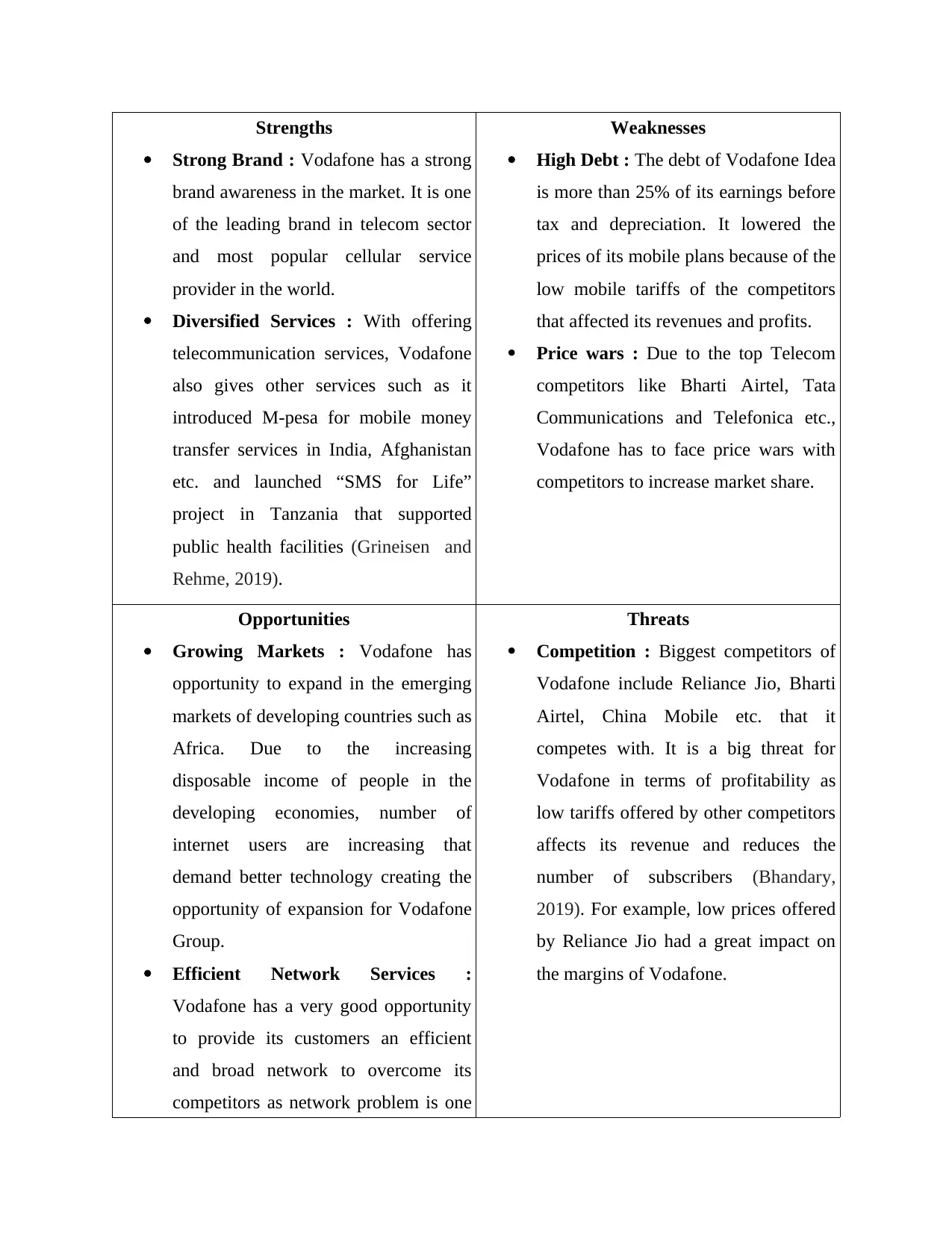
Strengths
Strong Brand : Vodafone has a strong
brand awareness in the market. It is one
of the leading brand in telecom sector
and most popular cellular service
provider in the world.
Diversified Services : With offering
telecommunication services, Vodafone
also gives other services such as it
introduced M-pesa for mobile money
transfer services in India, Afghanistan
etc. and launched “SMS for Life”
project in Tanzania that supported
public health facilities (Grineisen and
Rehme, 2019).
Weaknesses
High Debt : The debt of Vodafone Idea
is more than 25% of its earnings before
tax and depreciation. It lowered the
prices of its mobile plans because of the
low mobile tariffs of the competitors
that affected its revenues and profits.
Price wars : Due to the top Telecom
competitors like Bharti Airtel, Tata
Communications and Telefonica etc.,
Vodafone has to face price wars with
competitors to increase market share.
Opportunities
Growing Markets : Vodafone has
opportunity to expand in the emerging
markets of developing countries such as
Africa. Due to the increasing
disposable income of people in the
developing economies, number of
internet users are increasing that
demand better technology creating the
opportunity of expansion for Vodafone
Group.
Efficient Network Services :
Vodafone has a very good opportunity
to provide its customers an efficient
and broad network to overcome its
competitors as network problem is one
Threats
Competition : Biggest competitors of
Vodafone include Reliance Jio, Bharti
Airtel, China Mobile etc. that it
competes with. It is a big threat for
Vodafone in terms of profitability as
low tariffs offered by other competitors
affects its revenue and reduces the
number of subscribers (Bhandary,
2019). For example, low prices offered
by Reliance Jio had a great impact on
the margins of Vodafone.
Strong Brand : Vodafone has a strong
brand awareness in the market. It is one
of the leading brand in telecom sector
and most popular cellular service
provider in the world.
Diversified Services : With offering
telecommunication services, Vodafone
also gives other services such as it
introduced M-pesa for mobile money
transfer services in India, Afghanistan
etc. and launched “SMS for Life”
project in Tanzania that supported
public health facilities (Grineisen and
Rehme, 2019).
Weaknesses
High Debt : The debt of Vodafone Idea
is more than 25% of its earnings before
tax and depreciation. It lowered the
prices of its mobile plans because of the
low mobile tariffs of the competitors
that affected its revenues and profits.
Price wars : Due to the top Telecom
competitors like Bharti Airtel, Tata
Communications and Telefonica etc.,
Vodafone has to face price wars with
competitors to increase market share.
Opportunities
Growing Markets : Vodafone has
opportunity to expand in the emerging
markets of developing countries such as
Africa. Due to the increasing
disposable income of people in the
developing economies, number of
internet users are increasing that
demand better technology creating the
opportunity of expansion for Vodafone
Group.
Efficient Network Services :
Vodafone has a very good opportunity
to provide its customers an efficient
and broad network to overcome its
competitors as network problem is one
Threats
Competition : Biggest competitors of
Vodafone include Reliance Jio, Bharti
Airtel, China Mobile etc. that it
competes with. It is a big threat for
Vodafone in terms of profitability as
low tariffs offered by other competitors
affects its revenue and reduces the
number of subscribers (Bhandary,
2019). For example, low prices offered
by Reliance Jio had a great impact on
the margins of Vodafone.
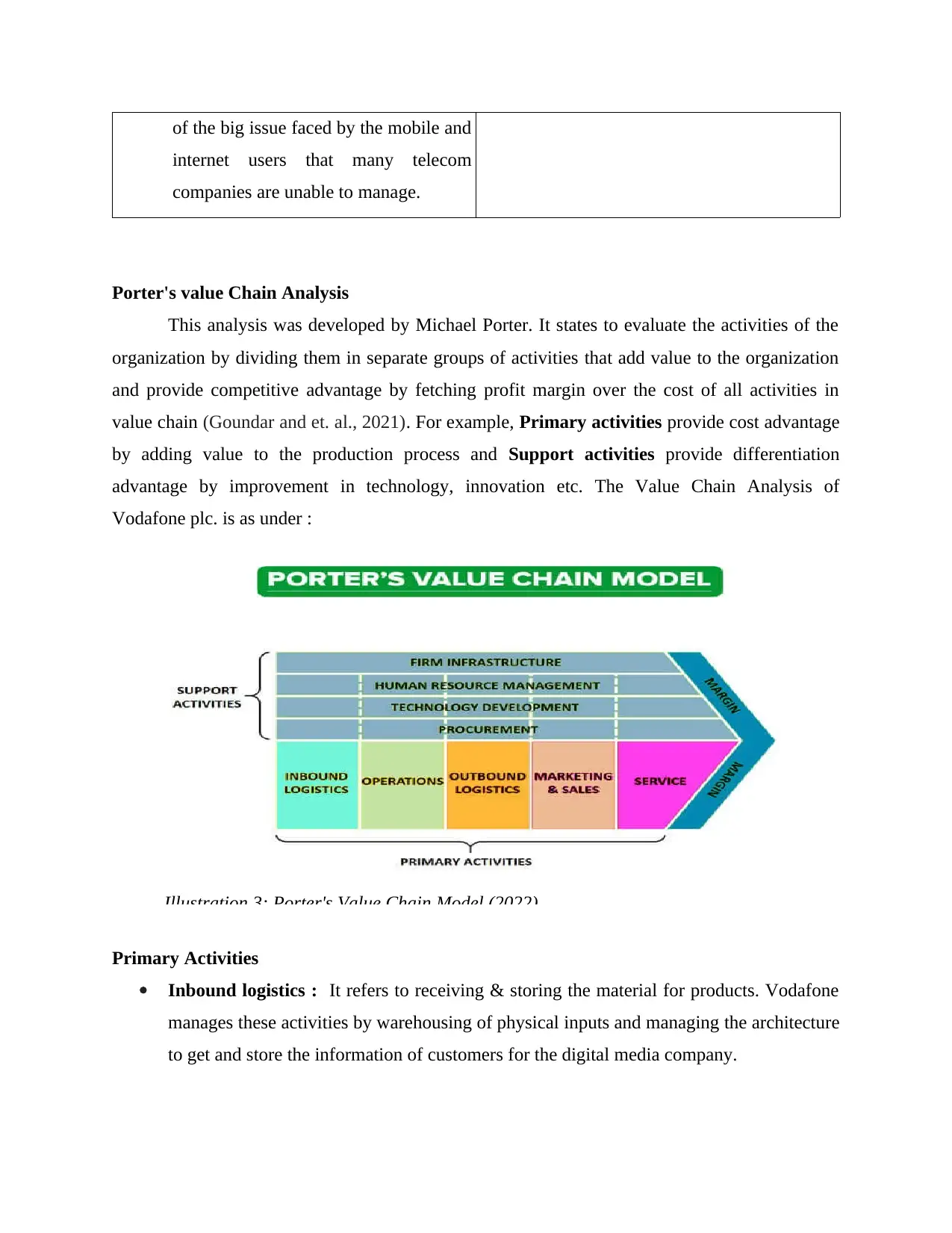
of the big issue faced by the mobile and
internet users that many telecom
companies are unable to manage.
Porter's value Chain Analysis
This analysis was developed by Michael Porter. It states to evaluate the activities of the
organization by dividing them in separate groups of activities that add value to the organization
and provide competitive advantage by fetching profit margin over the cost of all activities in
value chain (Goundar and et. al., 2021). For example, Primary activities provide cost advantage
by adding value to the production process and Support activities provide differentiation
advantage by improvement in technology, innovation etc. The Value Chain Analysis of
Vodafone plc. is as under :
Primary Activities
Inbound logistics : It refers to receiving & storing the material for products. Vodafone
manages these activities by warehousing of physical inputs and managing the architecture
to get and store the information of customers for the digital media company.
Illustration 3: Porter's Value Chain Model (2022)
internet users that many telecom
companies are unable to manage.
Porter's value Chain Analysis
This analysis was developed by Michael Porter. It states to evaluate the activities of the
organization by dividing them in separate groups of activities that add value to the organization
and provide competitive advantage by fetching profit margin over the cost of all activities in
value chain (Goundar and et. al., 2021). For example, Primary activities provide cost advantage
by adding value to the production process and Support activities provide differentiation
advantage by improvement in technology, innovation etc. The Value Chain Analysis of
Vodafone plc. is as under :
Primary Activities
Inbound logistics : It refers to receiving & storing the material for products. Vodafone
manages these activities by warehousing of physical inputs and managing the architecture
to get and store the information of customers for the digital media company.
Illustration 3: Porter's Value Chain Model (2022)
⊘ This is a preview!⊘
Do you want full access?
Subscribe today to unlock all pages.

Trusted by 1+ million students worldwide
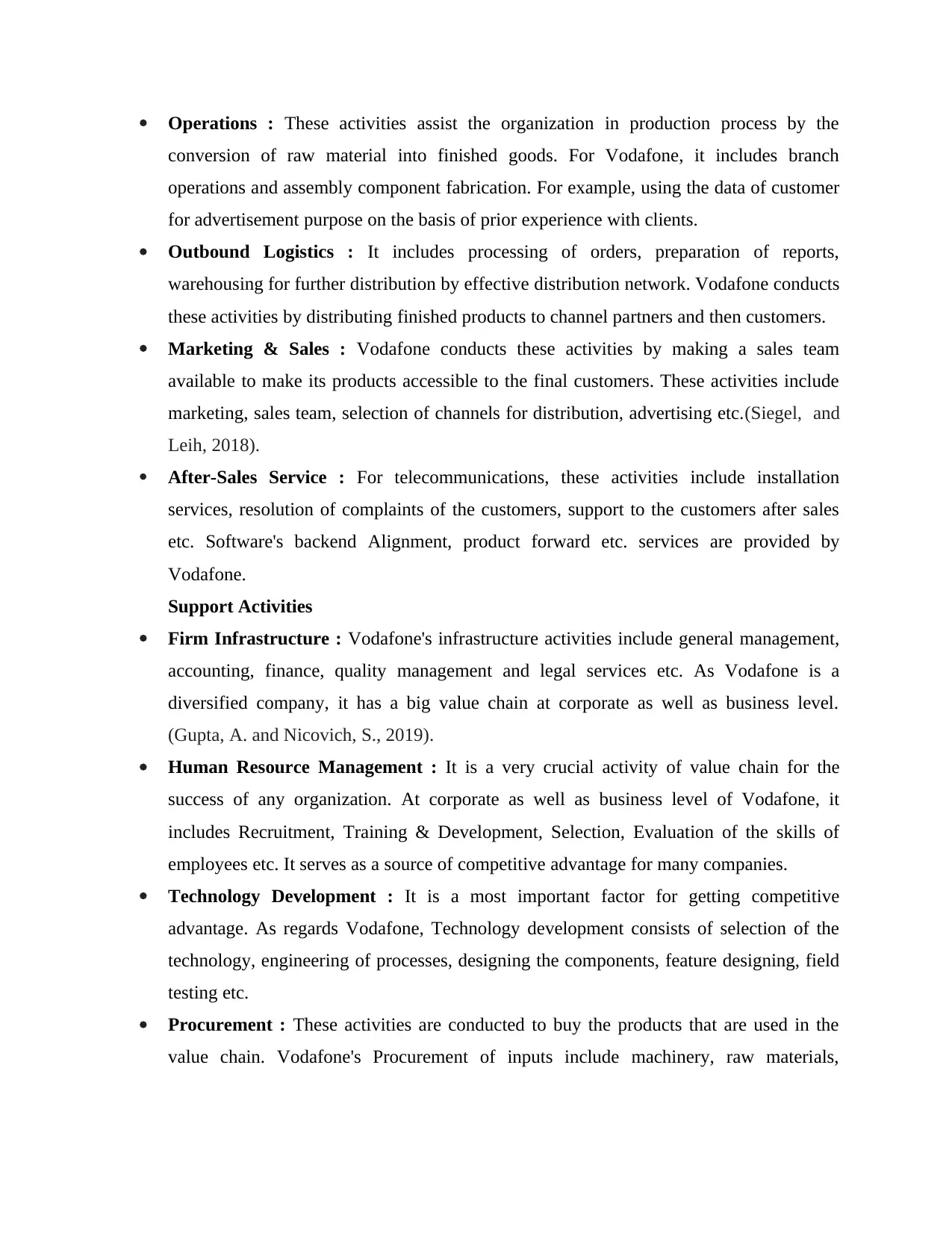
Operations : These activities assist the organization in production process by the
conversion of raw material into finished goods. For Vodafone, it includes branch
operations and assembly component fabrication. For example, using the data of customer
for advertisement purpose on the basis of prior experience with clients.
Outbound Logistics : It includes processing of orders, preparation of reports,
warehousing for further distribution by effective distribution network. Vodafone conducts
these activities by distributing finished products to channel partners and then customers.
Marketing & Sales : Vodafone conducts these activities by making a sales team
available to make its products accessible to the final customers. These activities include
marketing, sales team, selection of channels for distribution, advertising etc.(Siegel, and
Leih, 2018).
After-Sales Service : For telecommunications, these activities include installation
services, resolution of complaints of the customers, support to the customers after sales
etc. Software's backend Alignment, product forward etc. services are provided by
Vodafone.
Support Activities
Firm Infrastructure : Vodafone's infrastructure activities include general management,
accounting, finance, quality management and legal services etc. As Vodafone is a
diversified company, it has a big value chain at corporate as well as business level.
(Gupta, A. and Nicovich, S., 2019).
Human Resource Management : It is a very crucial activity of value chain for the
success of any organization. At corporate as well as business level of Vodafone, it
includes Recruitment, Training & Development, Selection, Evaluation of the skills of
employees etc. It serves as a source of competitive advantage for many companies.
Technology Development : It is a most important factor for getting competitive
advantage. As regards Vodafone, Technology development consists of selection of the
technology, engineering of processes, designing the components, feature designing, field
testing etc.
Procurement : These activities are conducted to buy the products that are used in the
value chain. Vodafone's Procurement of inputs include machinery, raw materials,
conversion of raw material into finished goods. For Vodafone, it includes branch
operations and assembly component fabrication. For example, using the data of customer
for advertisement purpose on the basis of prior experience with clients.
Outbound Logistics : It includes processing of orders, preparation of reports,
warehousing for further distribution by effective distribution network. Vodafone conducts
these activities by distributing finished products to channel partners and then customers.
Marketing & Sales : Vodafone conducts these activities by making a sales team
available to make its products accessible to the final customers. These activities include
marketing, sales team, selection of channels for distribution, advertising etc.(Siegel, and
Leih, 2018).
After-Sales Service : For telecommunications, these activities include installation
services, resolution of complaints of the customers, support to the customers after sales
etc. Software's backend Alignment, product forward etc. services are provided by
Vodafone.
Support Activities
Firm Infrastructure : Vodafone's infrastructure activities include general management,
accounting, finance, quality management and legal services etc. As Vodafone is a
diversified company, it has a big value chain at corporate as well as business level.
(Gupta, A. and Nicovich, S., 2019).
Human Resource Management : It is a very crucial activity of value chain for the
success of any organization. At corporate as well as business level of Vodafone, it
includes Recruitment, Training & Development, Selection, Evaluation of the skills of
employees etc. It serves as a source of competitive advantage for many companies.
Technology Development : It is a most important factor for getting competitive
advantage. As regards Vodafone, Technology development consists of selection of the
technology, engineering of processes, designing the components, feature designing, field
testing etc.
Procurement : These activities are conducted to buy the products that are used in the
value chain. Vodafone's Procurement of inputs include machinery, raw materials,
Paraphrase This Document
Need a fresh take? Get an instant paraphrase of this document with our AI Paraphraser

buildings, equipments for laboratory and offices etc. Procurement also requires
information systems, supplier chain management etc.
VRIO Analysis
It is an internal analysis of the organization's resources and their capabilities that provide
competitive advantage to the business. It determines most organised resources of the company
that provide sustainable competitive advantage to its business. The following is VRIO internal
Analysis of Vodafone :
Valuable : Value refers to the ability of organization to provide valuable resources to the
customers over its competitors. The valuable resources of Vodafone include its Brand,
Network capability, human resources , access to capital, high customer rating ,
implementation of digital strategy, intellectual property rights etc.
Rarity : It refers to the unique capabilities of the resources that cannot be made
accessible to the competitors. Vodafone's rare resources include brand awareness;
customer's network , customer community due to its ability to develop connectivity with
customers; intellectual property rights such as trademarks & copyrights etc. that provide
strong competitive advantage to the company (Tantau, A.D. and Frăţilă, 2021).
Imitable : It means the ability of the competitors to imitate or copy the resources of the
organization. In context with Vodafone, its digital strategy & customer's network can be
imitated by the competitors but its intellectual property rights and customers community
i.e. culture and community dedication are hard to imitate.
Illustration 4: VRIO Analysis (2021)
information systems, supplier chain management etc.
VRIO Analysis
It is an internal analysis of the organization's resources and their capabilities that provide
competitive advantage to the business. It determines most organised resources of the company
that provide sustainable competitive advantage to its business. The following is VRIO internal
Analysis of Vodafone :
Valuable : Value refers to the ability of organization to provide valuable resources to the
customers over its competitors. The valuable resources of Vodafone include its Brand,
Network capability, human resources , access to capital, high customer rating ,
implementation of digital strategy, intellectual property rights etc.
Rarity : It refers to the unique capabilities of the resources that cannot be made
accessible to the competitors. Vodafone's rare resources include brand awareness;
customer's network , customer community due to its ability to develop connectivity with
customers; intellectual property rights such as trademarks & copyrights etc. that provide
strong competitive advantage to the company (Tantau, A.D. and Frăţilă, 2021).
Imitable : It means the ability of the competitors to imitate or copy the resources of the
organization. In context with Vodafone, its digital strategy & customer's network can be
imitated by the competitors but its intellectual property rights and customers community
i.e. culture and community dedication are hard to imitate.
Illustration 4: VRIO Analysis (2021)
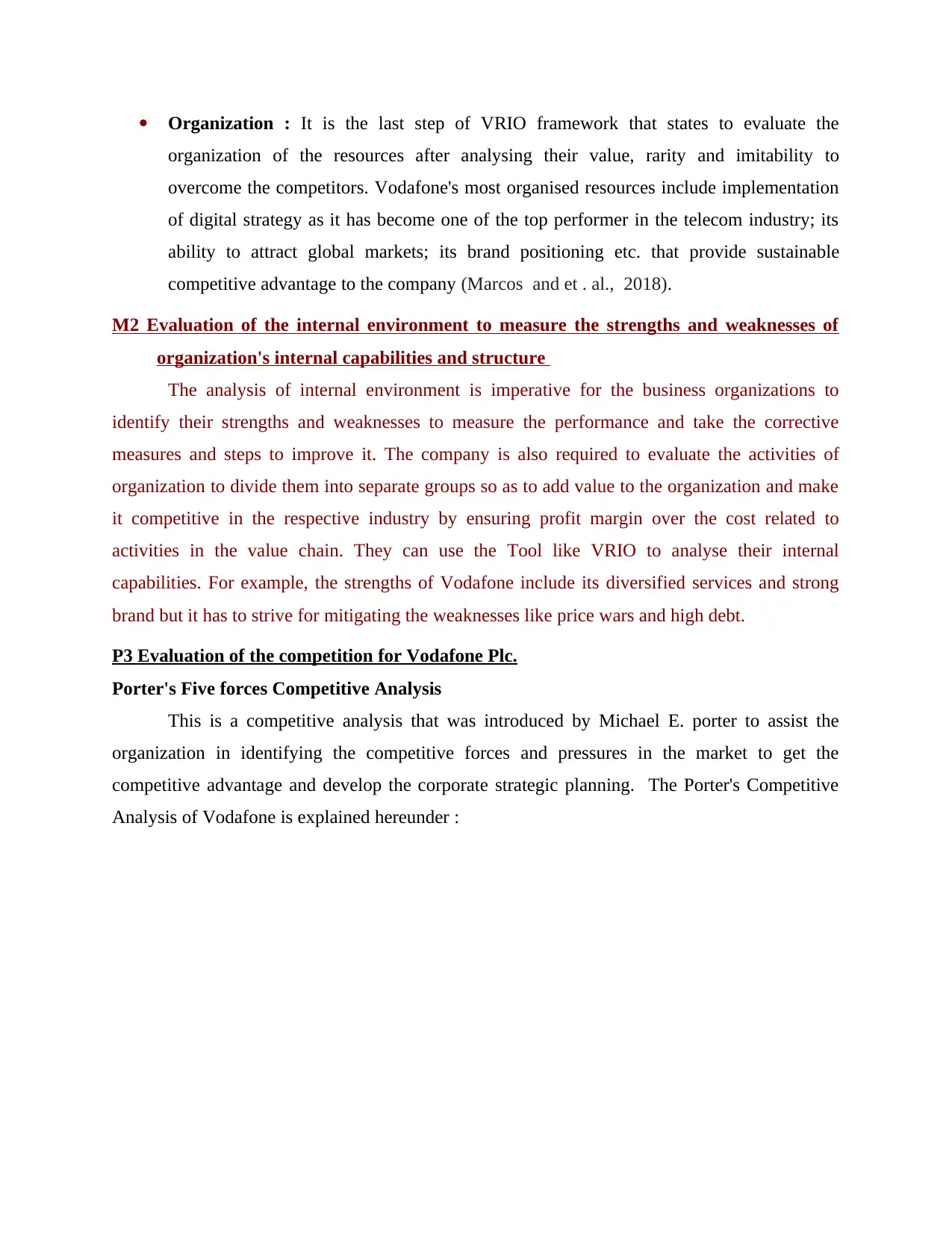
Organization : It is the last step of VRIO framework that states to evaluate the
organization of the resources after analysing their value, rarity and imitability to
overcome the competitors. Vodafone's most organised resources include implementation
of digital strategy as it has become one of the top performer in the telecom industry; its
ability to attract global markets; its brand positioning etc. that provide sustainable
competitive advantage to the company (Marcos and et . al., 2018).
M2 Evaluation of the internal environment to measure the strengths and weaknesses of
organization's internal capabilities and structure
The analysis of internal environment is imperative for the business organizations to
identify their strengths and weaknesses to measure the performance and take the corrective
measures and steps to improve it. The company is also required to evaluate the activities of
organization to divide them into separate groups so as to add value to the organization and make
it competitive in the respective industry by ensuring profit margin over the cost related to
activities in the value chain. They can use the Tool like VRIO to analyse their internal
capabilities. For example, the strengths of Vodafone include its diversified services and strong
brand but it has to strive for mitigating the weaknesses like price wars and high debt.
P3 Evaluation of the competition for Vodafone Plc.
Porter's Five forces Competitive Analysis
This is a competitive analysis that was introduced by Michael E. porter to assist the
organization in identifying the competitive forces and pressures in the market to get the
competitive advantage and develop the corporate strategic planning. The Porter's Competitive
Analysis of Vodafone is explained hereunder :
organization of the resources after analysing their value, rarity and imitability to
overcome the competitors. Vodafone's most organised resources include implementation
of digital strategy as it has become one of the top performer in the telecom industry; its
ability to attract global markets; its brand positioning etc. that provide sustainable
competitive advantage to the company (Marcos and et . al., 2018).
M2 Evaluation of the internal environment to measure the strengths and weaknesses of
organization's internal capabilities and structure
The analysis of internal environment is imperative for the business organizations to
identify their strengths and weaknesses to measure the performance and take the corrective
measures and steps to improve it. The company is also required to evaluate the activities of
organization to divide them into separate groups so as to add value to the organization and make
it competitive in the respective industry by ensuring profit margin over the cost related to
activities in the value chain. They can use the Tool like VRIO to analyse their internal
capabilities. For example, the strengths of Vodafone include its diversified services and strong
brand but it has to strive for mitigating the weaknesses like price wars and high debt.
P3 Evaluation of the competition for Vodafone Plc.
Porter's Five forces Competitive Analysis
This is a competitive analysis that was introduced by Michael E. porter to assist the
organization in identifying the competitive forces and pressures in the market to get the
competitive advantage and develop the corporate strategic planning. The Porter's Competitive
Analysis of Vodafone is explained hereunder :
⊘ This is a preview!⊘
Do you want full access?
Subscribe today to unlock all pages.

Trusted by 1+ million students worldwide
1 out of 21
Related Documents
Your All-in-One AI-Powered Toolkit for Academic Success.
+13062052269
info@desklib.com
Available 24*7 on WhatsApp / Email
![[object Object]](/_next/static/media/star-bottom.7253800d.svg)
Unlock your academic potential
Copyright © 2020–2026 A2Z Services. All Rights Reserved. Developed and managed by ZUCOL.


